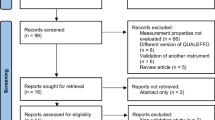Abstract
A brief Osteoporosis-Targeted Quality of Life (OPTQoL) questionnaire was previously developed as a cross-sectional survey instrument to assess the community impact of osteoporosis on quality of life in women. The initial development process involving item generation through focus groups, item reduction, and content and construct validation yielded a 36-item questionnaire with three domains (physical difficulty, adaptations and fears) and 10 health-related questions. In the present study, test-retest reliability and internal consistency of the questionnaire were assessed in a mail-based study with two clinical sites. Two hundred women (50 with severe osteoporosis, 50 with osteopenia, 50 with normal bone mineral density (BMD) and 50 with osteoarthritis and normal BMD), aged 43–84 years, completed the self-administered questionnaire initially and again about 2 weeks later. Using weighted kappas, agreement between questionnaire administrations ranged from 0.60 to 0.80 for most of the individual items. Intraclass correlation coefficients to assess reliability for the domain scores were 0.93 (physical difficulty), 0.82 (adaptations) and 0.88 (fears). Internal consistency of each of the domains was also high, with Cronbach’s alpha coefficients ranging from 0.89 to 0.91. Four items were dropped from the 36-item questionnaire due to high percentage of ‘not applicable’ responses. Results of the analyses support the validity and reliability of this instrument as a cross-sectional survey tool for assessing the impact of osteoporosis on quality of life in women living in the community. The questionnaire has been translated and culturally adapted into seven languages to allow cross-cultural studies of the community impact of osteoporosis.
Similar content being viewed by others
References
Who Study Group on Assessment of Fracture Risk and its Application to Screening for Postmenopausal Osteoporosis: a report of a WHO Study Group. WHO technical report series. 843. Geneva: WHO 1994:6.
US Congress, Office of Technology Assessment. Hip fracture outcomes in people age 50 and over: background paper. OTA-BP-H-120 Washington, DC: US Government Printing Office, July 1994.
Melton LJ, Chrischilles EA, Cooper C, et al. Perspective. How many women have osteoporosis? J Bone Miner Res 1992;7:1005–10.
Gold D, Smith S, Bales C, Lyles K, et al. Osteoporosis in late life. Does health locus of control affect psychosocial adaptation? J Am Geriatr Soc 1991;39:670–5.
Gold D, Drezner MK. Quality of life. In: Melton LJ III, Riggs BL, editors. Osteoporosis: etiology, diagnosis and management. 2nd ed. Philadelphia: Lippincott-Raven, 1995.
Ettinger B, Black DM, Nevitt MC, et al. Contribution of vertebral deformities to chronic back pain and disability. J Bone Miner Res 1992;7:449–56.
Lydick E, Yawn B, Love B, et al. Development and validation of a discriminative quality of life questionnaire for osteoporosis (OPTQoL). J Bone Miner Res 1997;12:456–63.
Lips P, Agnusdei D, Caulin C, et al. The validation of the EFFO questionnaire for quality of life in patients with vertebral osteoporosis (QUALEFFO). Osteoporos Int 1996;6(Suppl):227.
Cook DJ, Guyatt GH, Adachi JD, et al. Quality of life issues in women with vertebral fractures due to osteoporosis. Arthritis Rheum 1993;36:750–6.
Lydick E, Ross PD, Dwyer J, et al. Development of an osteoporosis targeted quality of life questionnaire. Osteoporos Int 1996;6(Suppl):127.
Radloff LS. The CES-D Scale: a self-report depression scale for research in the general population. Appl Psychol Measurement 1977;1:385–401.
McHorney CA, Ware JE, Rogers N, et al. The validity and relative precision of MOS short- and long-form health status scales and Dartmouth coop charts. Med Care 1992;30:MS253–65.
Deyo RA, Diehr P, Patrick DL. Reproducibility and health status measures: statistics and strategies for evaluation. Control Clin Trials 1991;12:S142–58.
Streiner DL, Norman GR. Health measurement scales: a practical guide to their development and use. Oxford: Oxford University Press, 1989.
Lin LI. A concordance correlation coefficient to evaluate reproducibility Biometrics 1989;45:255–68.
Patrick DL, Erikson P. Health status and policy: quality of life in health care evaluation and resource allocation. New York: Oxford University Press, 1993.
Nunnally JC. Psychometric theory. 2nd ed. New York: McGraw-Hill, 1978.
Devellis R. Scale development, theory and applications. Applied Social Research Methods Series, vol 26. Newbury Park: Sage Publications, 1991.
Lyles KW, Gold DW, Shipp KM, et al. Association of osteoporotic vertebral compression fractures with impaired functional status. Am J Med 1993;94:595–601.
Lydick E, Yawn B, Martin A, et al. The impact of fears on quality of life in a silent disease. Clin Ther 1996;18:1307–15.
Guillemin F, Bombardier C, Beaton D. Cross-cultural adaptation of health-related quality of life measures: literature review and proposed guidelines. J Clin Epidemiol 1993;46:1427–32.
Author information
Authors and Affiliations
Rights and permissions
About this article
Cite this article
Chandler, J.M., Martin, A.R., Girman, C. et al. Reliability of an osteoporosis-targeted quality of life survey instrument for use in the community: OPTQoL. Osteoporosis Int 8, 127–135 (1998). https://doi.org/10.1007/BF02672508
Received:
Accepted:
Issue Date:
DOI: https://doi.org/10.1007/BF02672508




